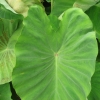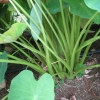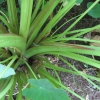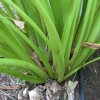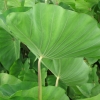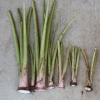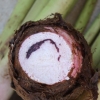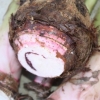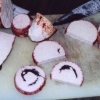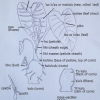Use As Food
Primarily as a table taro.
Distribution
Found only occasionally under māla (dryland) culture on the island of Hawai‘i. According to J.K., Lihilihimolina was reported growing in a garden in Puna in 1967, then it disappeared. It was not seen again until the 1990s, when a farmer found it in an abandoned lo‘i in Waipio Valley. He brought it to a kalo workshop J.K. was holding in Hilo and the cresent in the corm was visible.
General Characteristics
Short to medium in height, well spreading, producing a few ‘ohā; easily identified by the unusual coloring of the ‘i‘o kalo (Corm) flesh; lilac-purple in the center, surrounded by white. This is the only taro having bicolored ‘i‘o kalo (Corm) flesh when you cut it open.
Ha (Petiole)
55 to 70 cm. long, rather drooping, yellowish-green flecked with reddish-brown near the kōhina (base), a faint, pale pink ring at the kōhina (base) with white for 3 to 5 cm. above the base.
Lau or Lu'au(Leaf Blade)
35 to 45 cm. long, 25 to 35 cm. wide, 30 to 35 cm. from tip to base of sinus (māwae), arrow head shaped, thin in texture, smooth and regular in outline; round leaf section (lobes) acute with wide lihi māwae (sinus).
'I'o kalo (Corm)
Conspicuously lilac-purple at center and white outside; skin white with purple along leaf-scar rings. When you cut the corm of lihilihimōlina you may find a purple semi-circle, half moon shaped mark inside.
Pua (Flower)
Remarks
Lihilihimolina tends to be resistant to Phytophthora root rot, a fungal disease that attacks the 'i'o kalo. It reputedly was the favorite variety of Queen Emma, wife of King Kamehameha IV. Remember the purple crescent.


